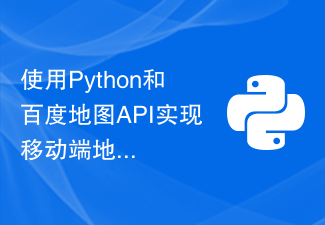Difference: 1. Web front-end development mainly refers to traditional PC-side web page development. Pages are mainly run in PC-side browsers. Pages developed by mobile front-end are mainly run on mobile phones. 2. The mobile terminal is mainly based on the webkit kernel and has better support for new technologies such as HTML5; while the web front-end requires compatibility with older versions of browsers such as IE in many scenarios, which in some cases limits the use of new technologies. 3. In terms of page adaptability, the adaptation of mobile pages is more difficult. 4. In terms of page performance, the performance of the web side is more stable than that of the mobile side.

The operating environment of this tutorial: Windows 7 system, Dell G3 computer.
According to the current general trend of front-end, front-end development is increasingly developing towards large front-end, and the content is also all-inclusive. Let’s talk about the difference between web front-end and mobile front-end.
1. Business application scenarios
Web front-end development mainly refers to traditional PC-side web page development. The page mainly runs in PC-side browsers. Mobile front-end development The pages that come out mainly run on mobile phones.
Intuitively, you will feel that the PC page is larger and the mobile page is smaller. However, according to development experience, a large page does not mean that the written code is complicated, and a small page does not mean that the development is simple or difficult. Dealing with transactions mainly depends on specific business needs.
2. Use of new technologies
Since the mobile terminal is mainly based on the webkit kernel, it has better support for new technologies such as HTML5, so it can be used in a wider range The use of new technologies, and PC-side development requires compatibility with older versions of browsers such as IE in many scenarios. Due to browser compatibility considerations, the use of new technologies is restricted in some cases.
3. Page adaptability
Traditional PC-side page development generally chooses to set a fixed width for the page, with white space on both sides, but for mobile Since the mobile phone screen of the page is much smaller than that of the PC, it is generally chosen to display as much content as possible on the mobile phone screen. This requires the mobile page to be able to fully adapt to mobile phones of various screen sizes and make maximum use.
From this point of view, the adaptation of mobile pages is more difficult.
4. Page performance
The network situation on the PC side is generally relatively stable, and all are connected to the network through network cables or Wi-Fi, but the mobile side is more complicated, except Wi-Fi, as well as 2G, 3G, 4G, and even switching between several different network connections often occur.
The challenge that unstable network connections bring to page performance is that the page resources on the mobile side should not be too large, otherwise the page will be inaccessible under poor network conditions, seriously affecting the user experience.
5. Frame selection
Due to the instability of the mobile network, we generally only consider small and beautiful frames when selecting mobile page frames. , for example, zepto.js only has 9.6K after compression, which can meet the needs of general business. If you want to build a more complex single-page application, you can choose a framework like vue.js, which is powerful in function but compressed in size. Later, it was only more than 20K.
The web side has a relatively large range of choices, and some heavier frameworks can also be considered based on project needs. For example, the ancient but huge ext.js is still active in some enterprises with its many UI components. In the background management system project.
(Learning video sharing: Getting started with web front-end)
The above is the detailed content of What is the difference between web front-end and mobile front-end. For more information, please follow other related articles on the PHP Chinese website!
 解决Vue移动端多触点问题Jun 30, 2023 pm 01:06 PM
解决Vue移动端多触点问题Jun 30, 2023 pm 01:06 PM在移动端开发中,我们经常会遇到多手指触控的问题。当用户在移动设备上使用多个手指滑动或缩放屏幕时,如何准确地识别和响应这些手势是一个重要的开发难题。在Vue开发中,我们可以采取一些措施来解决移动端多手指触控问题。一、使用vue-touch插件vue-touch是一个用于Vue的手势插件,它可以方便地处理移动端的多手指触控事件。我们可以通过npm安装vue-to
 Vue开发中如何解决移动端双击放大问题Jun 29, 2023 am 11:06 AM
Vue开发中如何解决移动端双击放大问题Jun 29, 2023 am 11:06 AM随着移动端设备的普及,使用Vue进行移动端开发已经成为了常见的选择。然而,我们在移动端开发过程中经常会面临一个问题,就是双击放大。本文将针对这一问题,探讨在Vue开发中如何解决移动端双击放大的具体方法。移动端双击放大问题的出现,主要是因为移动设备在触摸屏上进行双击操作时,会自动放大网页的缩放比例。对于一般的网页开发来说,这种双击放大通常是有好处的,因为它可以
 使用Python和百度地图API实现移动端地图定位功能的方法Jul 29, 2023 pm 11:33 PM
使用Python和百度地图API实现移动端地图定位功能的方法Jul 29, 2023 pm 11:33 PM使用Python和百度地图API实现移动端地图定位功能的方法随着移动互联网的发展,地图定位功能在移动端应用中变得越来越常见。Python作为一种流行的编程语言,也可以通过使用百度地图API来实现移动端地图定位功能。下面将介绍使用Python和百度地图API实现地图定位功能的步骤,并提供相应的代码示例。步骤一:申请百度地图API密钥在开始之前,我们首先需要申请
 如何处理PHP表单中的移动端和响应式设计Aug 10, 2023 am 11:51 AM
如何处理PHP表单中的移动端和响应式设计Aug 10, 2023 am 11:51 AM如何处理PHP表单中的移动端和响应式设计随着移动设备的普及和使用频率的增加,以及越来越多的用户使用移动设备访问网站,适配移动端成为了一个重要的问题。在处理PHP表单时,我们需要考虑如何实现移动端友好的界面和响应式设计。本文将介绍如何处理PHP表单中的移动端和响应式设计,并提供代码示例。1.使用HTML5的响应式表单HTML5提供了一些新特性,可以方便地实现响
 Vue开发:优化移动端手势缩放卡顿问题Jun 30, 2023 pm 04:33 PM
Vue开发:优化移动端手势缩放卡顿问题Jun 30, 2023 pm 04:33 PMVue开发中如何解决移动端手势缩放页面卡顿问题近年来,移动端应用的普及使得手势操作成为用户交互的重要方式。在Vue开发中,实现移动端手势缩放功能往往会遇到页面卡顿的问题。本文将探讨如何解决这一问题,并提供一些优化策略。了解手势缩放原理在解决问题之前,我们首先需要了解手势缩放的原理。手势缩放通过监听触摸事件来实现,当用户用两个手指滑动屏幕时,页面会按照手指的滑
 Vue移动端消除点击穿透问题的解决方案Jul 01, 2023 am 08:27 AM
Vue移动端消除点击穿透问题的解决方案Jul 01, 2023 am 08:27 AMVue开发中如何解决移动端点击穿透问题移动端上经常会遇到点击穿透的问题,即用户在快速点击元素时,由于点击事件的执行时间较长,下一个元素会被穿透点击。这在开发中会造成一系列的问题,例如多次触发事件、页面跳转错误等。针对这个问题,Vue提供了几种解决方案。一、使用FastClick库FastClick是一个能够消除click事件在移动端300ms的延迟库。安装和
 如何使用PHP生成可用于移动端的二维码?Aug 26, 2023 pm 02:51 PM
如何使用PHP生成可用于移动端的二维码?Aug 26, 2023 pm 02:51 PM如何使用PHP生成可用于移动端的二维码?随着移动互联网的快速发展,二维码成为了商家推广、支付、活动等方方面面的重要工具。而使用PHP生成可用于移动端的二维码则成为了许多开发人员的需求。在本文中,我们将介绍如何使用PHP生成可用于移动端的二维码,并附上代码示例供参考。首先,我们需要先安装并引入一个PHP库,名为"endroid/qr-code"。这个库提供了一
 Vue开发中如何解决移动端图片旋转问题Jun 29, 2023 pm 09:22 PM
Vue开发中如何解决移动端图片旋转问题Jun 29, 2023 pm 09:22 PM随着移动互联网的快速发展,越来越多的网站和应用程序开始采用Vue.js进行移动端开发。然而,在移动端开发过程中,经常会遇到图片旋转的问题。图片旋转是指当用户在移动设备上拍摄照片时,由于设备方向的变化,导致照片在页面上显示的角度与实际拍摄的角度不一致。解决图片旋转问题,首先需要了解图片旋转的原因。当用户在移动设备上拍摄照片时,设备会自动为照片添加一些元数据,其


Hot AI Tools

Undresser.AI Undress
AI-powered app for creating realistic nude photos

AI Clothes Remover
Online AI tool for removing clothes from photos.

Undress AI Tool
Undress images for free

Clothoff.io
AI clothes remover

AI Hentai Generator
Generate AI Hentai for free.

Hot Article

Hot Tools

SAP NetWeaver Server Adapter for Eclipse
Integrate Eclipse with SAP NetWeaver application server.

MinGW - Minimalist GNU for Windows
This project is in the process of being migrated to osdn.net/projects/mingw, you can continue to follow us there. MinGW: A native Windows port of the GNU Compiler Collection (GCC), freely distributable import libraries and header files for building native Windows applications; includes extensions to the MSVC runtime to support C99 functionality. All MinGW software can run on 64-bit Windows platforms.

VSCode Windows 64-bit Download
A free and powerful IDE editor launched by Microsoft

MantisBT
Mantis is an easy-to-deploy web-based defect tracking tool designed to aid in product defect tracking. It requires PHP, MySQL and a web server. Check out our demo and hosting services.

mPDF
mPDF is a PHP library that can generate PDF files from UTF-8 encoded HTML. The original author, Ian Back, wrote mPDF to output PDF files "on the fly" from his website and handle different languages. It is slower than original scripts like HTML2FPDF and produces larger files when using Unicode fonts, but supports CSS styles etc. and has a lot of enhancements. Supports almost all languages, including RTL (Arabic and Hebrew) and CJK (Chinese, Japanese and Korean). Supports nested block-level elements (such as P, DIV),






